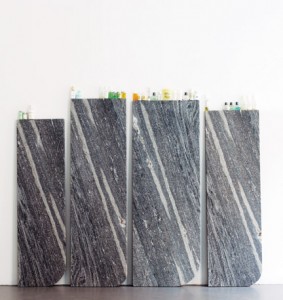« Reviews
Gabriel Kuri: Nobody needs to know the price of your Saab
Institute of Contemporary Art - Boston
By Irina Leyva-Pérez
“Nobody needs to know the price of your Saab” is the title of Gabriel Kuri’s first solo exhibition in a museum in the United States. The exhibition was organized by the Blaffer Art Museum at the University of Houston, and is currently on view at the Institute of Contemporary Art in Boston. Kuri was born in Mexico in 1970, and he is based in Mexico City and Brussels. His exhibition résumé includes important shows and biennials such as Venice and Berlin, and this year he was selected as the Armory Show Commissioned Artist.
Consistent with the work that he is known for, in this exhibition Kuri criticizes the excessive consumerism that dominates contemporary society. By choosing everyday objects as materials, he is reinforcing this idea, in what can be seen as a recycling sequence. Have we ever stopped to consider how much we waste on any given day? Paper receipts, plastic containers, shopping bags, just to mention a few. How much of our lives are influenced, and even determined, by consumerism? Do we really need all what we buy?

Gabriel Kuri, Complementary cornice and intervals, 2009 Marble slabs, courtesy cosmetics, 58 7/8” x 71 5/8” x 3 1/8”. Courtesy of the artist and Franco Noero Gallery, Turin. Photo: John Kennard.
The pieces in this exhibition are made from two main viewpoints: one that takes advantage of the ready-made tradition in art, initiated by Duchamp and his iconic urinal, and a second that creates pieces to resemble everyday objects. By taking things that we discard daily and transforming them into artworks, Kuri is showing us that they can be used to make art, and to comment on social and political issues.
In Complementary Cornice and Intervals (2009), he presents us with tall marble slabs acting like shelves on top of which he placed small cosmetics bottles, those usually offered by hotels. The piece establishes a dialogue between the permanent nature of marble, a high-end hard stone, versus the disposable quality of the plastic bottles.
Untitled (Superama) is an impressive triptych, and perhaps the highlight of the exhibition. Kuri took his supermarket receipts from Superama, a kind of Walmart in Mexico, from purchases he did years apart. The three times he purchased the same products, and of course, the total amount was different every year due to inflation. The receipts were converted into hand-woven tapestries, to the tiniest detail, replicating even the ink marks. Standing in front of the piece, beautifully crafted, we can’t avoid thinking about the waste generated by all the receipts that are printed daily and the ephemeral character of it. He did another similar piece, in which the same concept was applied: hand-woven wool tapestries made after receipts. In this instance he used vouchers from his bank and titled the piece Trinity, making an ironic parallel between the relevance of money and a religious concept, pairing them at a sacred level.
Another piece that could make you choke in surprise is Column 2009-2010, made in 2010. Kuri took all the receipts he received during a year and inserted them on steel rods, arranged by date. The fact that one person could generate this quantity of receipts, and put together that amount of paper, which inevitably ends in the trash, is a clear demonstration of the excessive consumerism and waste involved in the day-to-day functioning of our society.
“Nobody needs to know the price of your Saab” is a subtle, ironic, and refined criticism to extreme consumerism that dominates contemporary society. It also contains strong social commentaries about class, inflation, and the value of money.
This conceptual and provoking type of art is questioning art and society at the same level. Contemporary art has pushed the boundaries of what is considered as such, and artists are constantly going beyond the traditional materials and concepts to include more daring concepts. At the same time, we can’t help but to think about how much art has become a filter and a way of commenting on social matters.
(February 2 - July 4, 2011)
Irina Leyva-Pérez is an art historian and critic based in Miami. She is the curator of Pan American Art Projects and former assistant curator at the National Gallery of Jamaica.
Filed Under: Reviews


































